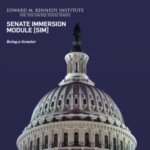As a nation, we place no greater responsibility on any one individual than we do on the president. Through these activities, students learn about the roles and responsibilities of the U.S. president and their own roles as citizens of a democracy.
The President’s Roles and Responsibilities: Communicating with the President

In order to become informed participants in a democracy, students must learn about the women and men who make decisions concerning their lives, their country, and the world. The president of the United States is one such leader. As a nation, we place no greater responsibility on any one individual than we do on the president. Through several activites, students learn about the roles and responsibilities of the U.S. president and their own roles as citizens of a democracy.
Women & the American Story: Growth and Turmoil, 1948-1976
This free curriculum unit from the New-York Historical Society explores the decades following World War II and considers the action that different groups took to advocate for their rights. Materials examine how shifting political and social ideologies impacted women’s lives and the roles women played in the wide array of activist-led movements that formed in the 1960s and 1970s.
The Constitutional Convention of 1787
In this unit, students will examine the roles that key American founders played in creating the Constitution, and the challenges they faced in the process. They will learn why many Americans in the 1780s believed that reforms to the Articles of Confederation were necessary, and the steps taken to authorize the 1787 Convention in Philadelphia. They will become familiar with the main issues that divided delegates at the Convention, particularly the questions of representation in Congress and the office of the presidency. Finally, they will see how a spirit of compromise, in the end, was necessary for the Convention to fulfill its task of improving the American political system.
The Amendment Process: Ratifying the 19th Amendment
In this activity, students will analyze historical records of Congress and the U.S. government to understand the sequence of steps in the amendment process. Students will study each document and match it to the step in the process that it illustrates.
When put in proper sequence, the documents will show the process by which the 19th Amendment – prohibiting the federal government or states from denying the right to vote on the basis of sex – was added to the Constitution.
Then students will reflect on the process, and the roles that the people, president, Congress and the states play.
Mock Trial Plan
In this lesson, students will stage a mock trial to resolve a hypothetical dispute. They will develop an understanding of the trial process, the roles of those in the courtroom and their importance to the administration of justice, and the significance of their constitutional protections.
The Role of the Courts (Separation of Powers)

In these five short videos, federal judges explain separation of powers and the roles of the three branches of government as well as landmark cases related to separation of powers. Judges also discuss our government’s system of checks and balances, and why it’s important to respect the nation’s rule of law and the jurisdiction of the courts.
Branches of Power
This game immerses students in the workings of our three branches of government. Players take on the roles of legislator, president and Supreme Court justice to get constitutional laws enacted. Players juggle several bills at once while holding press conferences and town hall meetings.
The Constitutional Convention: What the Founding Fathers Said

By examining records of the Constitutional Convention, such as James Madison’s extensive notes, students witness the unfolding drama of the Constitutional Convention and the contributions of those who have come to be known as the Founding Fathers: Madison, Benjamin Franklin, George Washington, and others who played major roles in founding a new nation. In this lesson, students will learn how the Founding Fathers debated, and then resolved, their differences as they drafted the U.S. Constitution.
Senate Immersion Module Curriculum

The materials in this curriculum are designed to enhance the Institute’s immersive SIM experience. The SIM is an educational, game-like experience, developed to engage new generations of Americans. This program is conducted in the Institute’s full- scale representation of the United States Senate Chamber. Running with up to 100 students at a time, participants take on the roles of senators to learn about representation, study issues, debate, negotiate, and vote on legislation.